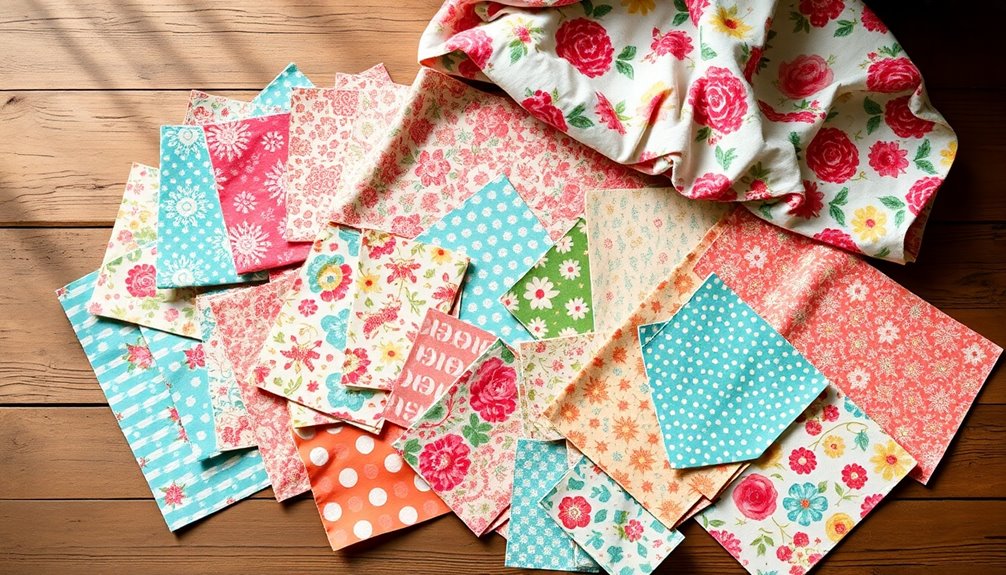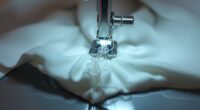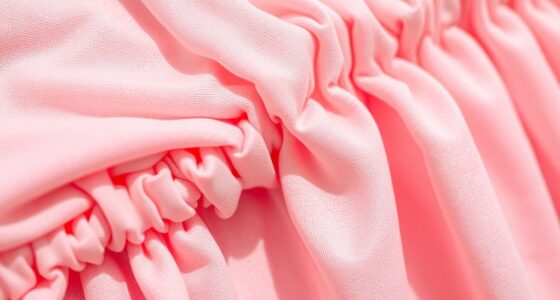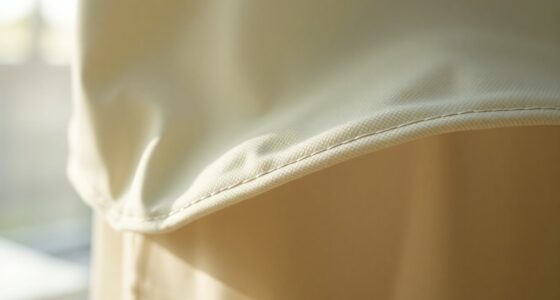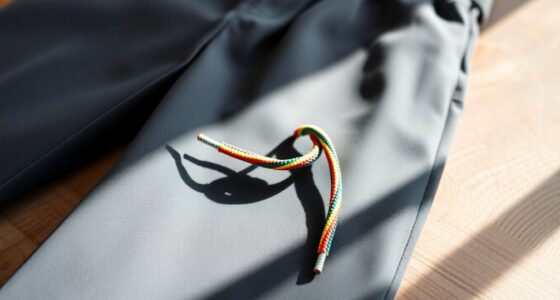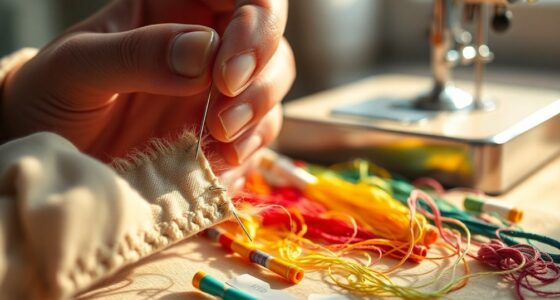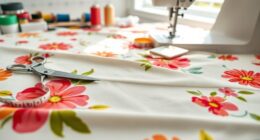To make a quilt, the number of fat quarters you need depends on the quilt size. A baby quilt typically requires about 4 fat quarters, while a twin-sized quilt needs around 24-30. For a queen, expect to use 36-45, and for a king size, you'll want 48-56. Remember, individual patterns may slightly adjust your needs. Keep going to discover more tips on choosing fabrics and managing your fat quarters effectively!
Key Takeaways
- A baby quilt typically requires about 4 fat quarters, while a crib quilt needs around 12-20 fat quarters.
- For a twin size quilt, you will need approximately 24-30 fat quarters.
- A queen size quilt generally requires 36-45 fat quarters to achieve the desired dimensions.
- King size quilts usually need between 48-56 fat quarters for a complete design.
- Consider specific patterns, as they may slightly alter fat quarter requirements based on design choices.
Understanding Fat Quarters
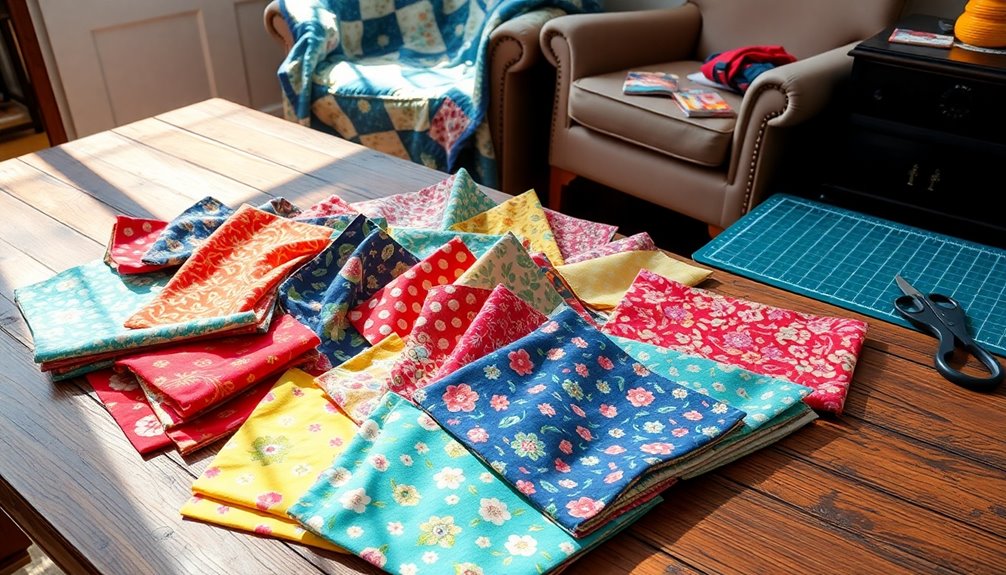
When you explore the world of quilting, understanding fat quarters becomes essential. A fat quarter measures 18 inches by 22 inches and consists of a quarter yard of fabric, making it a versatile choice for your quilt top.
These pieces are typically sold individually or in bundles, offering a wealth of colors and patterns to enhance your designs. The full width of fabric ranges from 40 to 44 inches, allowing for diverse fabric measuring options.
Fat quarters are perfect for creating cohesive quilt designs, as you can mix and match them while maintaining a consistent aesthetic. Many quilters build a collection of fat quarters, providing endless possibilities for various projects beyond just quilting.
Factors Affecting Quilt Size
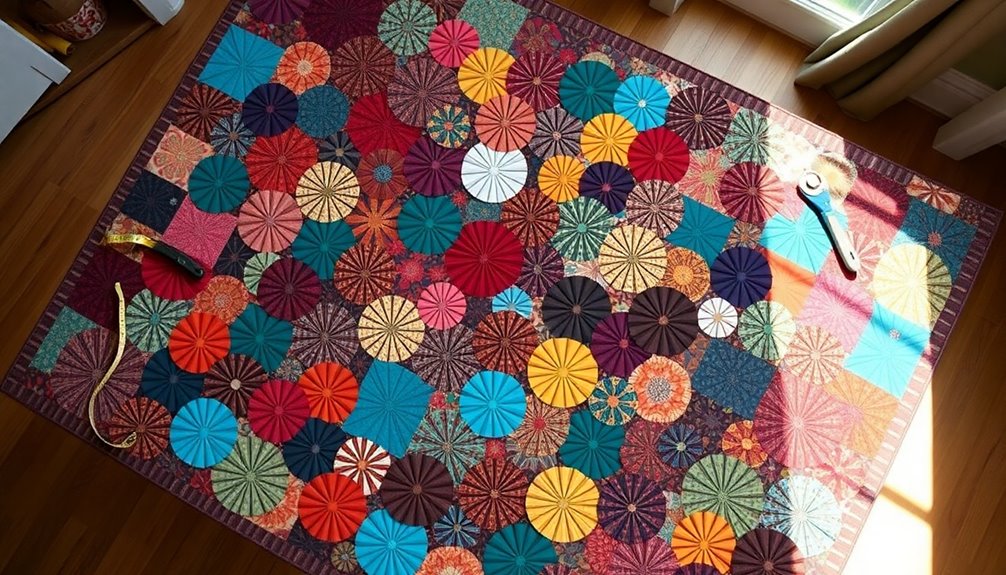
When you're planning a quilt, the size and purpose really matter.
Your fabric design and layout choices can also impact how many fat quarters you'll need.
Let's explore these factors to help you determine the right amount of fabric for your project.
Quilt Dimensions and Purpose
Understanding the purpose of your quilt is essential, as it directly impacts its dimensions and the number of fat quarters you'll need.
If you're making a baby quilt, for instance, you'll typically aim for dimensions around 35 x 41 inches, requiring about 4 fat quarters.
For larger quilts like a twin size, measuring around 70 x 82 inches, you'll need approximately 16 fat quarters.
As quilt size increases, so does the need for a quilt; a queen quilt measures 87.5 x 102.5 inches and needs around 25 fat quarters, while a king size, at 105 x 102.5 inches, requires about 30.
Always remember to account for additional fabric for borders and backing when planning your quilt dimensions.
Fabric Design and Layout
Fabric design and layout play an essential role in determining how many fat quarters you'll need for your quilt. The quilt size influences how much fabric you require, with larger quilts needing more fat quarters for blocks and borders.
When planning your quilt, consider the finished size of each block; smaller blocks mean you'll need more fabric to meet your desired dimensions. Different patterns can also impact your fat quarter requirements, especially if they include sashing or borders.
Additionally, the arrangement of colors and prints in your layout design can increase fabric usage, as intricate designs often necessitate careful selection. Don't forget to account for seam allowances, as they reduce the effective size of each piece.
Fat Quarter Requirements for Different Quilt Sizes
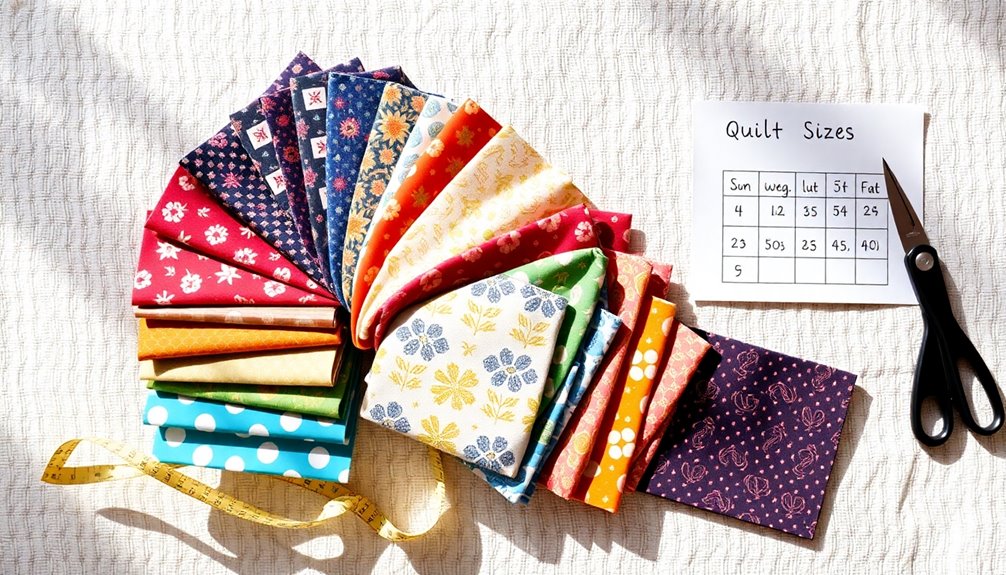
Creating a quilt requires careful planning, especially when it comes to the number of fat quarters needed for different sizes.
For a twin size quilt, you'll need about 24-30 fat quarters, which will give you a quilt measuring roughly 70 x 82 inches.
If you're aiming for a queen size quilt, expect to gather 36-45 fat quarters to achieve dimensions of approximately 87.5 x 102.5 inches.
On the larger side, a king size quilt typically requires 48-56 fat quarters, measuring around 105 x 102.5 inches.
Keep in mind that specific patterns, like the Yellow Brick Road, may alter these requirements slightly, so always consider your design when planning your fabric needs.
Estimating Fat Quarters Needed for Your Design
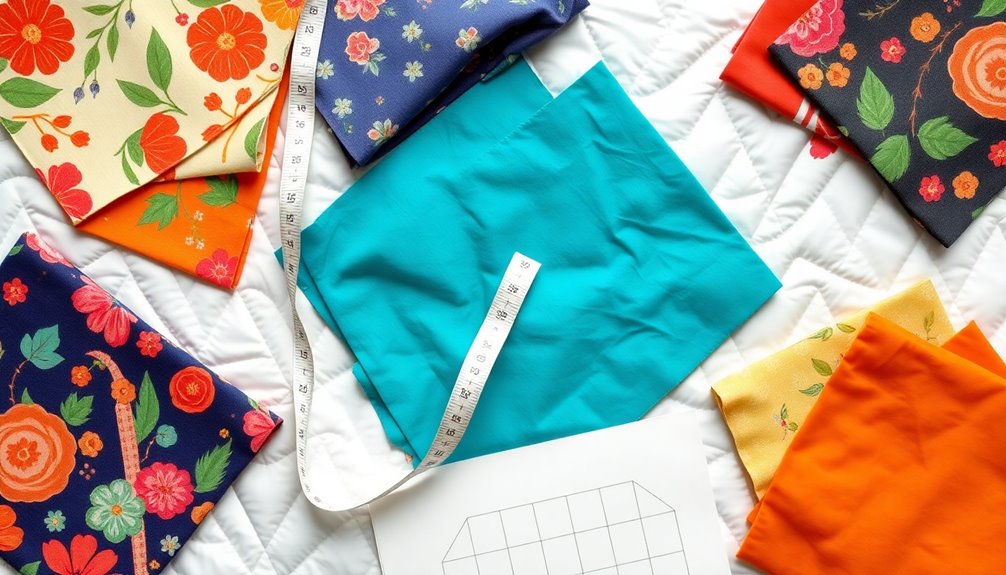
When planning your quilt, estimating the number of fat quarters you'll need can be straightforward if you follow a few key guidelines.
Start by determining your quilt size. For example, a baby quilt typically requires 16-20 fat quarters, while a twin size needs 24-30.
Larger quilts, like queen and king sizes, often need 36-45 and 48-56 fat quarters, respectively.
Remember, a fat quarter measures 18 x 22 inches, allowing for various cut sizes based on your pattern.
Don't forget to factor in seam allowances, as they can affect your finished pieces.
Using a cheat sheet for estimating quilt size based on fat quarters can simplify the process, ensuring you have enough fabric to bring your design to life.
Calculating Fabric for Borders and Backing

Once you've estimated the number of fat quarters needed for your quilt, it's time to think about the borders and backing.
For borders, add 6-12 inches of fabric depending on how wide you want them.
When calculating backing, measure the total quilt size and add an extra 4-8 inches on each side for adequate coverage. A standard backing fabric width is 44-45 inches, so determine how many widths you'll need based on your quilt dimensions.
If you're using fat quarters for either borders or backing, remember to factor in seam allowances, which require extra fabric.
Finally, always round up your fabric yardage calculations to avoid running short, ensuring a smooth quilting process.
Tips for Beginner Quilters
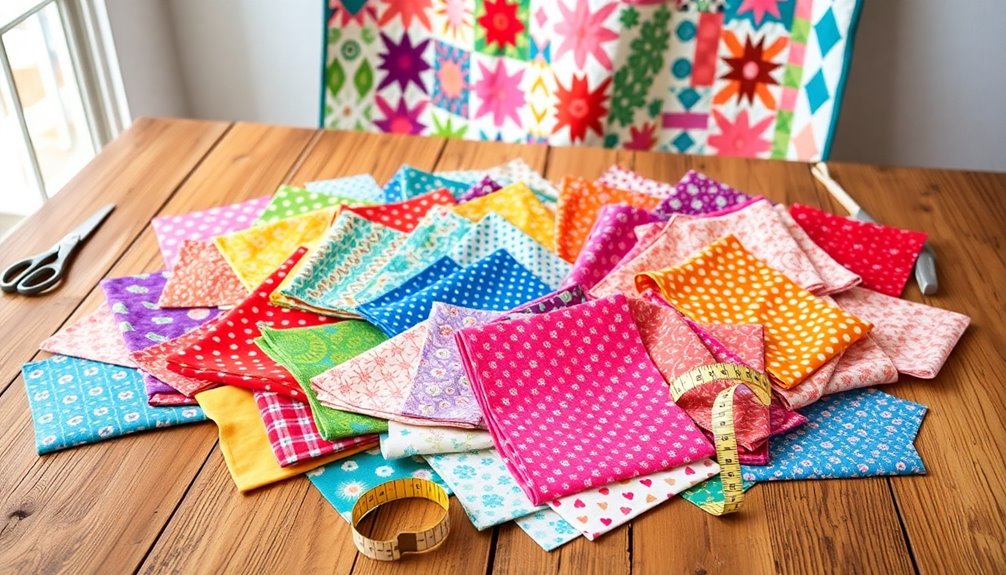
Starting your quilting journey can be exciting yet overwhelming, but focusing on smaller projects can help ease you into the craft.
Begin with crib or lap quilts, which typically need around 12-20 fat quarters. This smaller quilt size makes handling and assembly much easier.
Look for patterns designed specifically for fat quarters, like the Irish Chain or Turning Twenty, to simplify your experience. You'll also want to choose half of your fabric in solid colors to create a cohesive look while working with various prints.
Remember, if you ever decide to tackle a king-size quilt, you'll need about 48-56 fat quarters!
Joining online quilting communities can provide the support and resources you need to thrive.
Popular Patterns for Fat Quarter Quilts
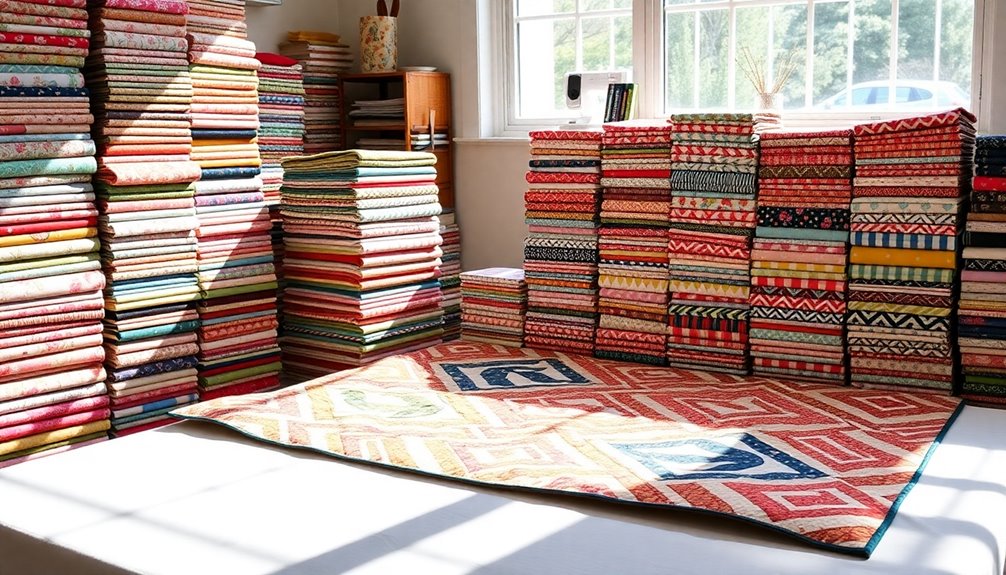
If you're looking to make the most of your fat quarters, several popular quilt patterns can help you create beautiful projects with ease.
The Yellow Brick Road pattern is a favorite, requiring 48 fat quarters for a king-size quilt and 30 for a queen-size quilt.
Another versatile option is the Bits and Pieces pattern, which calls for 40 fat quarters for a king-size quilt and 33 for a queen-size quilt.
If you want something simpler, the Irish Chain pattern is perfect for beginners and can be adapted using solid backgrounds.
For a quick project, the Turning Twenty pattern lets you use just 20 fat quarters while still crafting stunning designs.
With these popular patterns, your fat quarter bundle can turn into something special!
Shopping for Fat Quarters: What to Consider
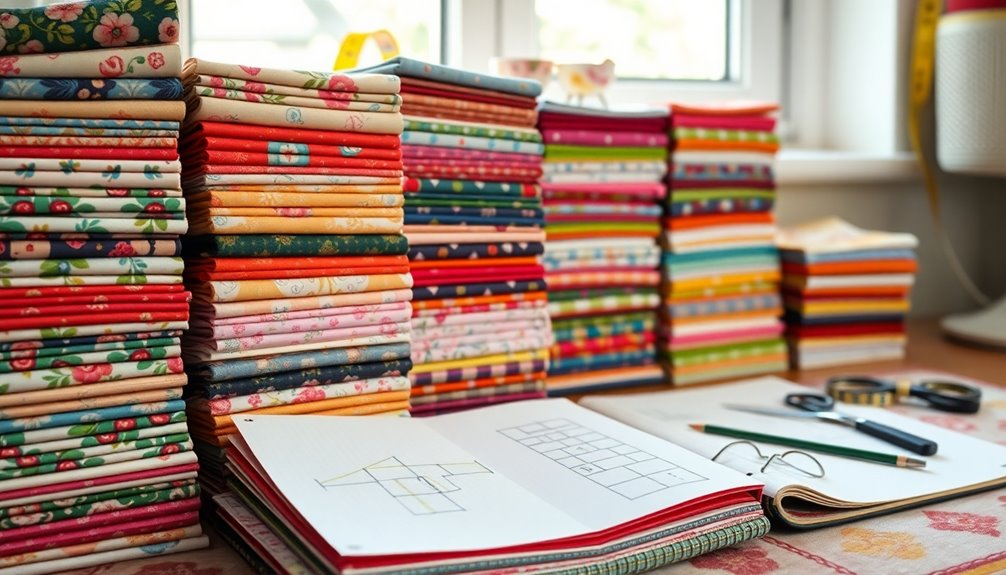
When you're shopping for fat quarters, keep your budget in mind to avoid overspending.
Consider the size of bundles and how many you'll need for your quilt project, as this can impact your overall cost.
Finally, pay attention to fabric selection; choosing a cohesive palette will enhance your quilt's design.
Budgeting for Fat Quarters
Budgeting for fat quarters is essential to guarantee you get the most value for your quilting projects. Typically, fat quarters cost around $3 each, but you can find bundles of 25 fat quarters for just $25, making it a smart buy.
Start by selecting your quilt pattern, as this helps determine the number of fat quarters you'll need, allowing for more accurate budgeting. Building a fabric stash is also beneficial; buying in bulk can save you money for future projects.
Keep an eye out for sales and discounts on fat quarter bundles, as retailers often run promotions that can greatly cut costs. Plus, variety in colors and prints can inspire creativity without overspending on individual fabrics.
Fabric Selection Tips
Choosing the right fat quarters can make or break your quilt project, so consider a few key factors before you shop.
First, think about the number of fat quarters you'll need based on your specific pattern. Look for bundles that offer a variety of colors and patterns to enhance your creative options.
It's wise to choose fabrics that fit your personal style and complement each other, as this will create a cohesive design in your quilt.
Don't forget to pay attention to fabric types; select high-quality cotton or blends that will hold up over time.
Finally, keep an eye out for sales, like 25 fat quarters for $25, to build your fabric stash without breaking the bank. Additionally, considering color palettes that reflect warmth can greatly influence the overall aesthetic of your quilt.
Understanding Bundle Sizes
Understanding bundle sizes is essential for making the most out of your fat quarter shopping experience. When you choose bundles, you often get a variety of colors and prints that can enhance your quilt project.
Here are some key points to take into account:
- Bundles typically contain 5 to 25 fat quarters.
- A good deal is around 25 for $25, making each fat quarter about $1.
- Selecting a quilting pattern beforehand helps determine fabric requirements.
- Reflect on your quilt size, as different patterns have varying fat quarter needs.
Managing Extra Fat Quarters
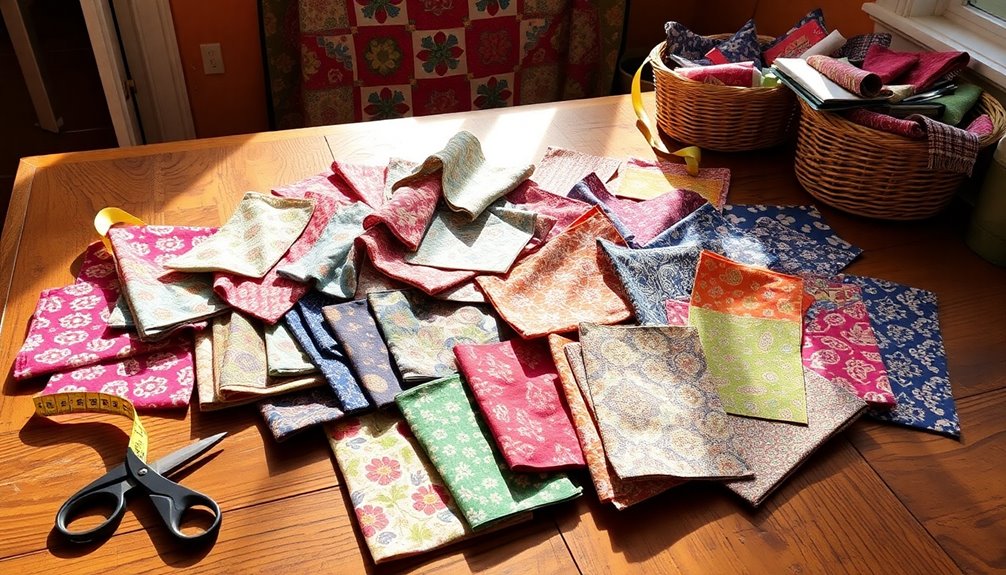
While you might find yourself with extra fat quarters after finishing a quilt, these pieces can be a valuable resource rather than a burden. You can use them in quilt backing or binding, which minimizes fabric waste while enhancing your design.
When planning for a queen or double size quilt, remember that the same number of fat quarters is needed, making it easier to strategize your fabric usage without incurring extra costs. Before buying more, consider how many fat quarters you'll need for the quilt top.
Additionally, think about incorporating leftover fat quarters into smaller pieces or other projects, like fabric accents, to maximize your creativity and prevent waste. Embrace those extras—they can lead to beautiful surprises!
Community Resources and Support for Quilters
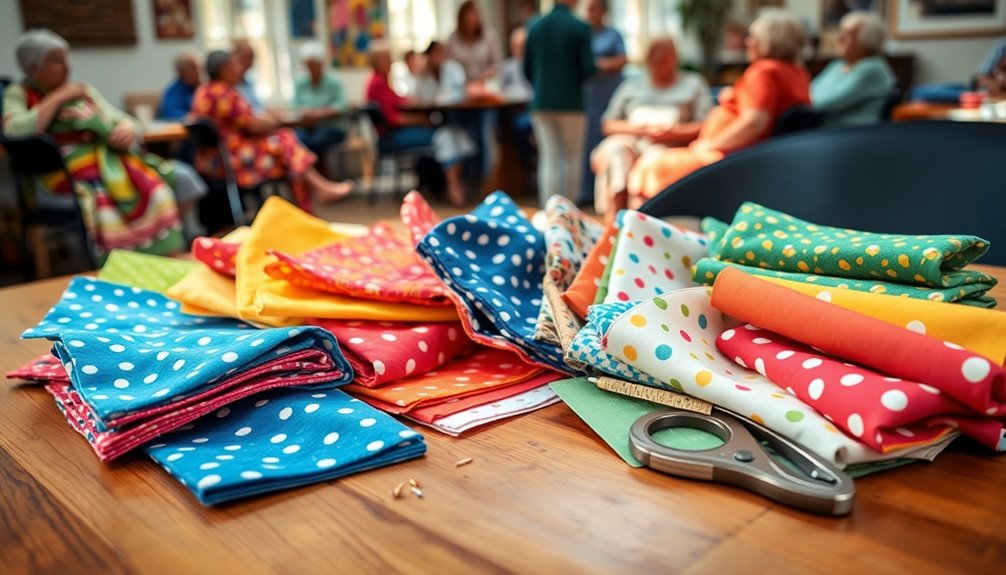
Quilters often find a wealth of resources and support within their communities, whether online or in-person. Here are some valuable options to explore:
- Community libraries often host quilting classes and workshops, offering hands-on learning experiences.
- Quilting groups provide opportunities to connect, collaborate on projects, and participate in charity events.
- Online forums and social media platforms let you share experiences and ask questions to seasoned quilters about your fabric needs.
- Many quilters share free resources, like cheat sheets and PDF guides, to help you estimate fabric requirements based on your fat quarters.
Frequently Asked Questions
How Many Fat Quarters Do You Need to Make a Lap Quilt?
To make a lap quilt, you'll typically need about 12 to 15 fat quarters, depending on the size and complexity you want.
Keep in mind that some patterns might specify the exact number you'll need, so check those before starting.
Don't forget to account for seam allowances, as they can reduce the usable fabric.
Mixing in solid fabrics or coordinating prints can really enhance your quilt's design while using a limited number of fat quarters.
What Size Quilt Can You Make With 12 Fat Quarters?
With 12 fat quarters, you can create a cozy lap quilt, measuring around 52.5 x 61.5 inches.
Picture yourself arranging 24 vibrant squares, each about 6.5 inches, forming a beautiful patchwork or intricate pattern like the Irish Chain.
As you design, you'll balance colors and textures, ensuring visual harmony.
If you decide to add 4 more fat quarters for borders, your quilt's potential expands, inviting even more creativity into your project!
Can I Make a Quilt With 10 Fat Quarters?
You can definitely make a quilt with 10 fat quarters!
It's all about how you plan and use those fabrics. For smaller quilts, like a baby or lap quilt, 10 fat quarters might work just fine, but you might need to incorporate some solids or mix patterns for variety.
Think about simple patchwork designs that maximize your fabric. With careful cutting and layout, you can create something beautiful and functional! Consider incorporating a variety of textures and colors to elevate your patchwork project. Additionally, if you have old sweaters that you no longer wear, learning how to shrink a sweater can transform these garments into usable fabric pieces for your design. Not only does this method minimize waste, but it also allows you to experiment with different patterns and styles in your patchwork creation.
What Size Quilt Will 2 Charm Packs Make?
With two charm packs, you can create a quilt approximately 40 inches by 50 inches when you lay out 80 charm squares in an 8 by 10 arrangement.
It's great for a lap-sized quilt! If you want something larger, consider adding sashing or borders.
Using patterns designed for charm packs can help you maximize your fabric and achieve your desired size.
Enjoy your quilting journey!
Conclusion
In the grand adventure of quilting, knowing how many fat quarters you need can feel like solving a mystery! With a sprinkle of creativity and a dash of planning, you can whip up a masterpiece that'll make even the most seasoned quilters green with envy. So grab those fat quarters, let your imagination run wild, and remember: every quilt you create is a story waiting to be told. Happy quilting—your fabric kingdom awaits!
